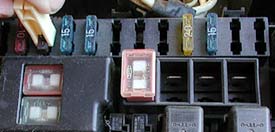
Replacing Fuses
Automotive circuit protection
Created by Tom Morr
Electrical problems can present one of the biggest troubleshooting challenges in automobiles. Unlike flat tires or other easily visible problems, electrical shortcomings can be tough to track down.
Fuse Function
Although many auto-electrical problems are better left to professionals in these days of computer-controlled vehicles, fuses are one common electrical bug that the average motorist can diagnose and fix. Basically, fuses are an intentional weak link in an electrical circuit. If too much current flows through the circuit for whatever reason, the fuse is designed to "blow" and stop the flow before electrical components are damaged, wires melt and cause a fire, and/or other nasty things. If a car's electrical accessory (such as the horn or radio) mysteriously stops working, the average motorist can potentially save a trip to the shop by checking the fuses first. Typically, fuse panels or "blocks" are located near the steering column, under or below the glovebox or in the engine compartment.
Fuse Types
Modern cars use either glass or blade-type fuses. Cylindrical-glass fuses aren't as common these days, and the more user-friendly blade-style "ATO" fuses began appearing in the '70s. (The two subspecies of ATO fuses are the early ATM style and smaller ATC configuration, which was introduced in the '90s.) They all perform the same function: When electrical current exceeds the circuit's capacity, this overload causes a wire inside the fuse to pop open, which stops the flow of electricity before further damage can be done.
Fuse diagnosis is straightforward: Look at the wire inside the fuse to see if it's continuous or "blown" open. If it's blown, remove and replace the fuse with one that has the same voltage and amperage rating. (Blade-type fuses are color-coded for easy selection.) Inexpensive plastic tools help remove the fuse without damaging it.
Electrical Problems
Unfortunately, the caveat here is that the original fuse blew for a reason. Even worse, fuses normally don't malfunction due to age or wear-and-tear. These are the two prominent causes of auto-electrical problems:
> Short Circuit: This occurs when the electrical current can't follow its normal path for some reason and flows directly to ground. Because the shorter route offers less resistance, the current can generate heat that degrades wiring and/or damages electrical components.
> Overload: This occurs when the flow of the electrical current exceeds the wiring and/or equipment's capacity in the circuit. Two causes of overloads are too many components on one circuit or when one of the devices malfunctions. Like circuit breakers, properly functioning fuses protect the circuit by opening, blocking the current flow before it can damage electrical components.
Resource
Cooper Bussman (Buss fuses), www.bussman.com
